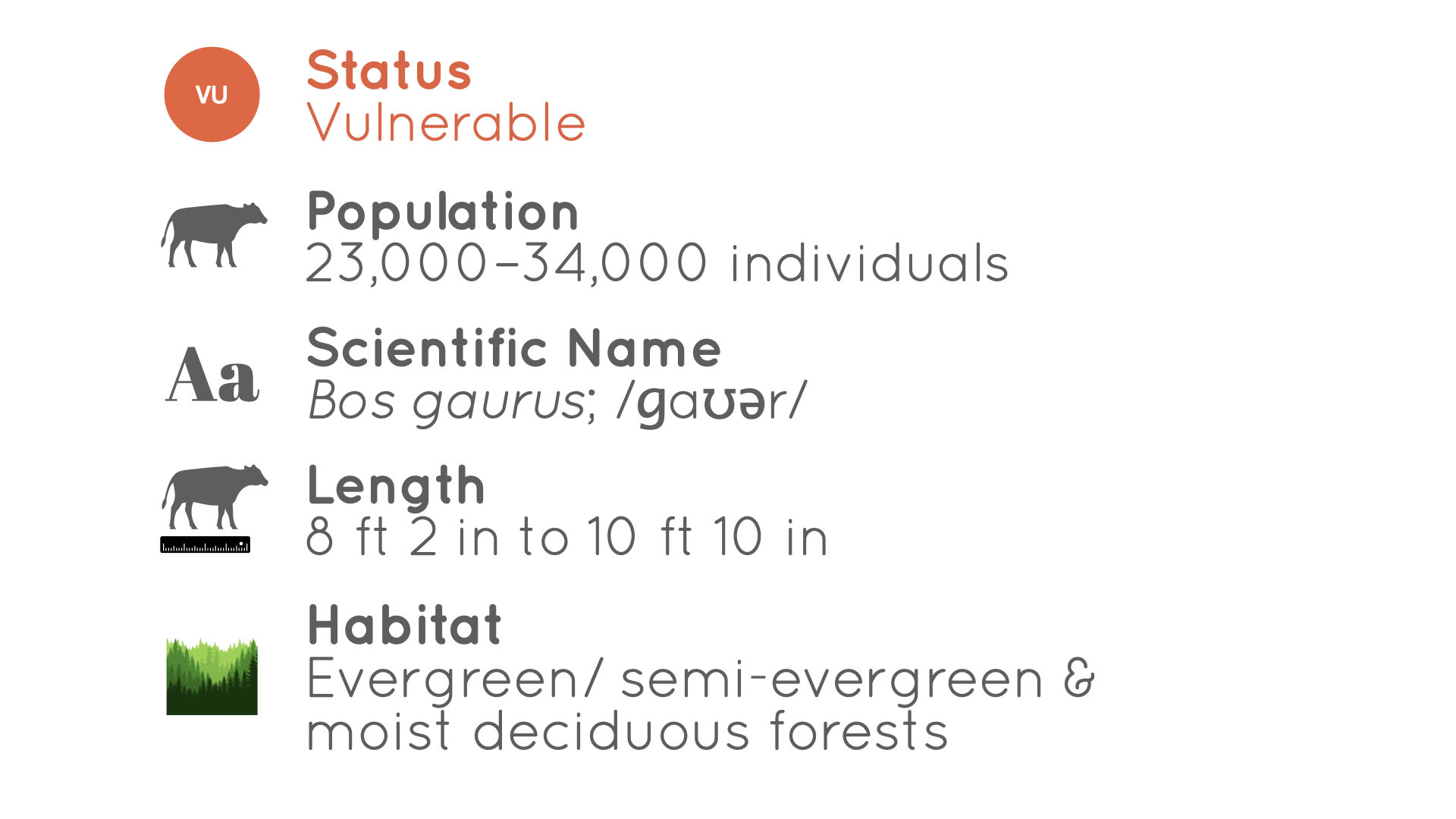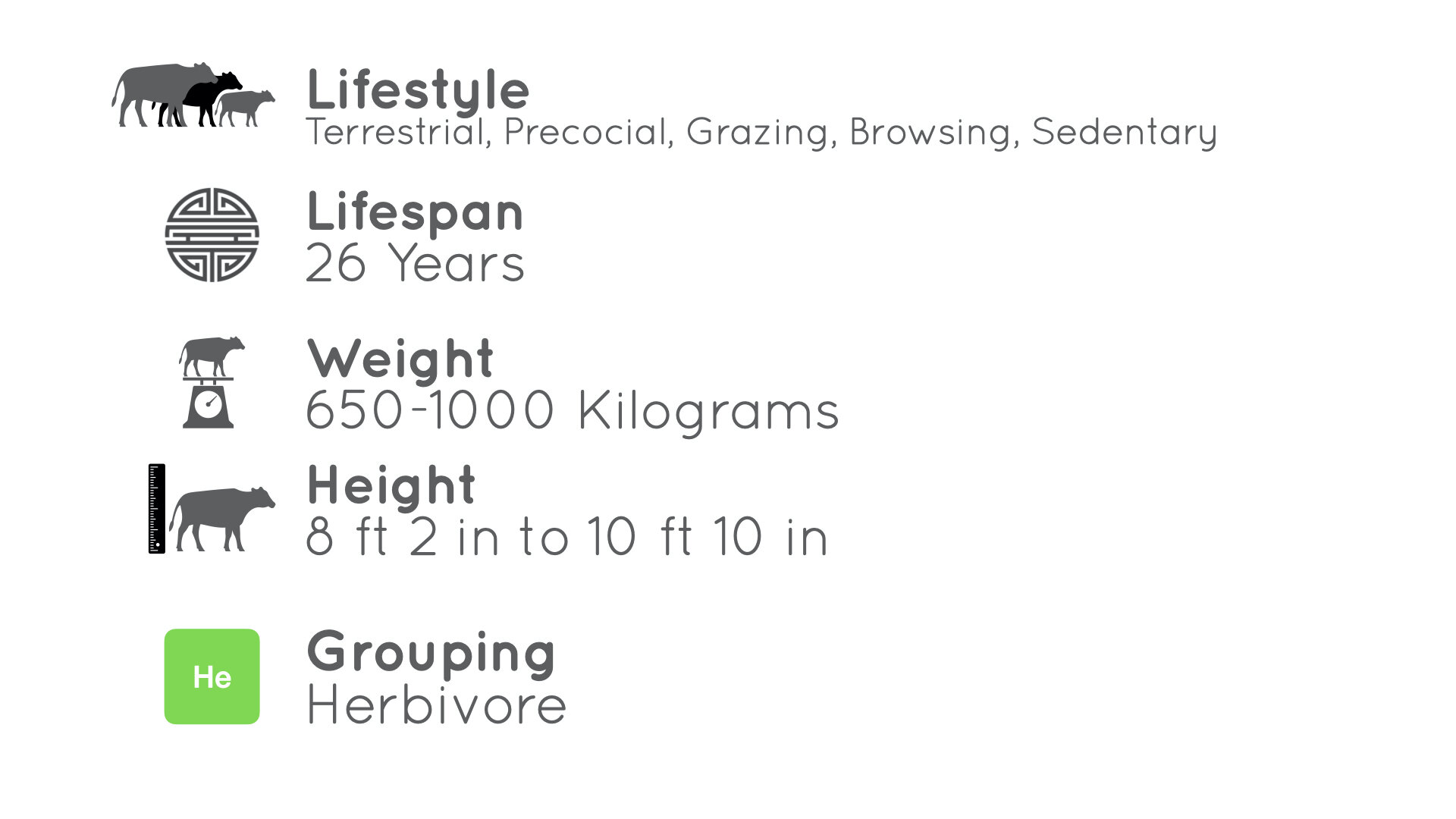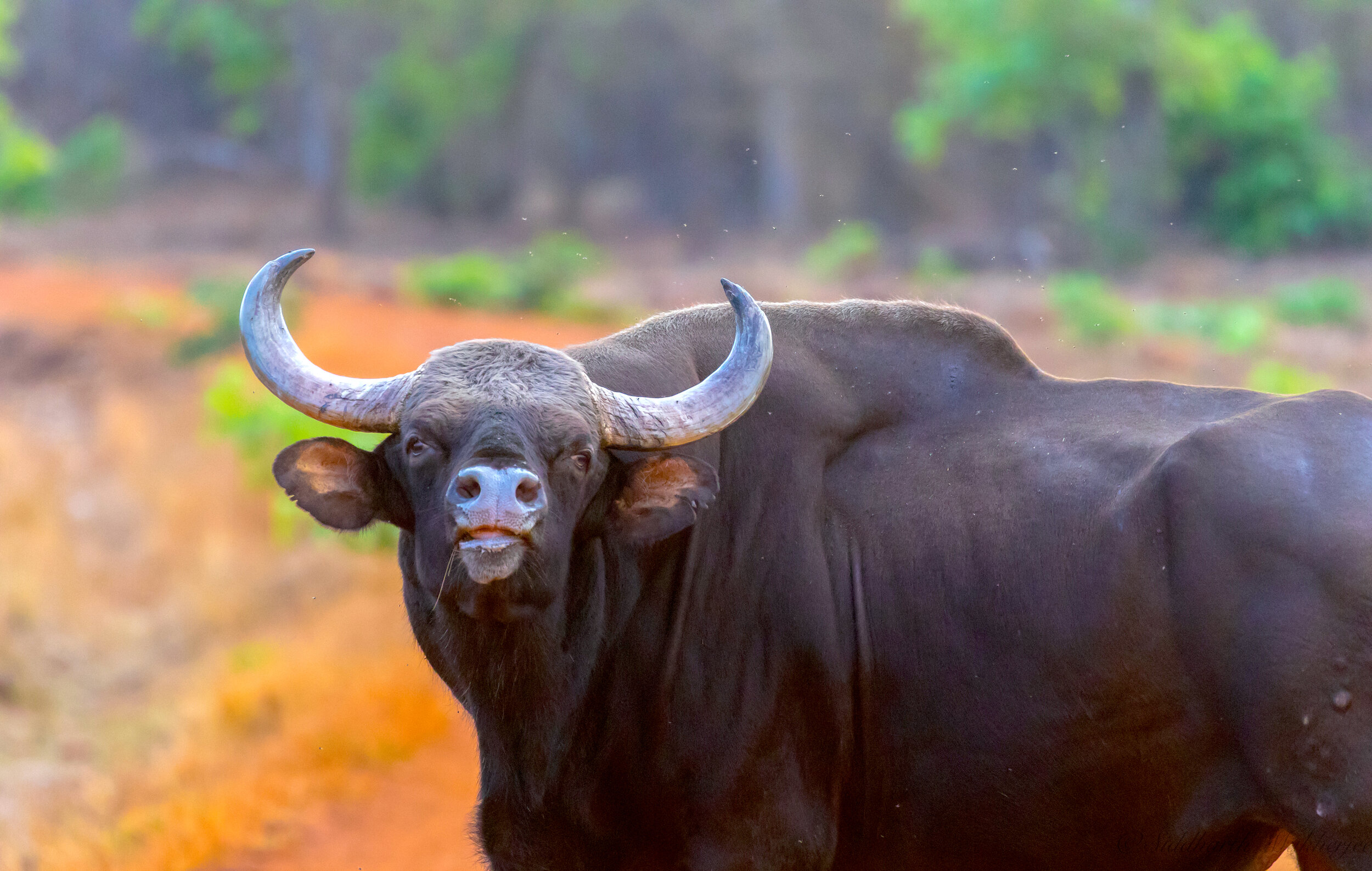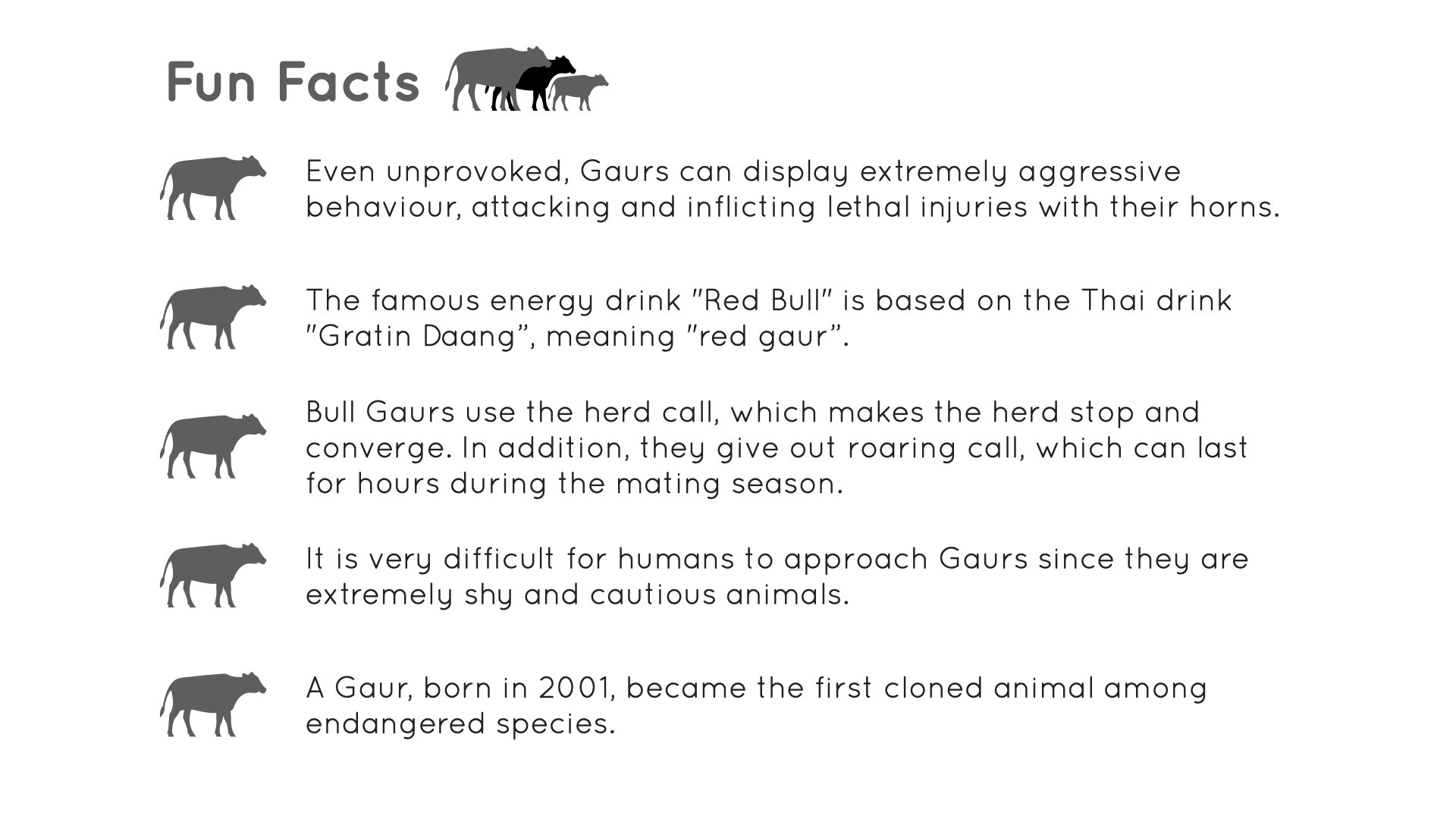Gaur
Bos gaurus; /ɡaʊər/
VULNERABLE
The Gaur (Bos gaurus), also called the Indian bison, is native to South and Southeast Asia and has been listed as Vulnerable on the IUCN Red List since 1986. The global population has been estimated at 23,000 to 34,000 individuals. It declined by more than 70% during the last three generations, and is extinct in Sri Lanka and probably also in Bangladesh. In well-protected areas, it is stable and increasing.
It is the largest species among the wild cattle and attains a shoulder height of 1.8 m (6 feet) or more. It is heavy-bodied and typically blue-eyed and has curving horns, a high ridge on the forepart of the back, and white “stockings” on the legs. Bulls are dark brown or blackish, cows and young reddish brown. Greatly reduced in numbers, gaurs survive only in scattered herds in India, Myanmar, West Malaysia, and Thailand. In Malaysia, it is called seladang, and pyaung in Myanmar. The domesticated form of the gaur is called gayal (Bos frontalis) or mithun.


The Gaur ranges from India to peninsular Malaysia. Its distribution, status and conservation in the Indian subcontinent are reviewed on the basis of available information, both published papers and unpublished census reports of forest departments, and field survey data from north-eastern India and parts of Bhutan and Nepal. The Gaur is found in three disjunct regions, south-western India, central India and north-eastern India (including Nepal, Bhutan and Bangladesh). Within these regions the distribution is highly fragmented and includes a number of small non-viable isolated populations. The habitat in north-eastern India is still contiguous with that in Bhutan, Myanmar and Bangladesh and to some extent with Nepal. Although the estimated population of the Gaur is 23,000–34 000, it is declining alarmingly. Populations outside the protected areas may not last long. An action plan has been proposed for its conservation. Their preferred habitat is grassy terrains and forested hills. In some areas of their range, these animals inhabit high elevations of up to 1800 meters.
Being one of the largest cattle species, this bovine has a massive head, deep body and solid limbs. The color of their body varies from reddish or brown to black while the limbs are pale colored. Both males and females have upwardly curved horns, growing from sides of their head. Their horns have yellow base and black tip. These animals have a hump on their shoulders, which is especially prominent in adult males. In addition, they have a distinct "dewlap" of skin, stretching from their throat to their forelegs. The Gaur is herbivorous animal. Being both a grazer and a browser, this bovine feeds mainly upon grass while leaves, forbs (a herbaceous flowering plant other than a grass), coarse and dry grasses are a good supplement to its usual diet.
Generally, Gaurs are most active in the morning and evening. However, they can be active by day or even become nocturnal, when living nearby human settlements. These sociable animals gather into herds, containing 8-11 or more individuals. A Gaur herd includes females and one dominant male. Home range of each herd covers about 78 sq. kilometers’ (30 sq. miles) territory. Bulls often congregate into bachelor herds while older males occasionally prefer living solitarily. Against a threat, the bull usually lowers its head and hind side, attacking the rival from the broadside with its horns. When alarmed, these animals give out a call known as "whistling snort".
Generally, Gaurs are most active in the morning and evening. However, they can be active by day or even become nocturnal, when living nearby human settlements. These sociable animals gather into herds, containing 8-11 or more individuals. A Gaur herd includes females and one dominant male. Home range of each herd covers about 78 sq. kilometers’ (30 sq. miles) territory. Bulls often congregate into bachelor herds while older males occasionally prefer living solitarily. Against a threat, the bull usually lowers its head and hind side, attacking the rival from the broadside with its horns. When alarmed, these animals give out a call known as "whistling snort".
In some regions in India where human disturbance is minor, the gaur is very timid and shy despite their great size and power. When alarmed, gaur crash into the jungle at a surprising speed. However, in Southeast Asia and South India, where they are used to the presence of humans, gaur are said by locals to be very bold and aggressive. They are frequently known to go into fields and graze alongside domestic cattle, sometimes killing them in fights. Gaur bulls may charge without provocation, especially during summer, when the intense heat and parasitic insects make them more short-tempered than usual. To warn other members of its herd of approaching danger, the gaur lets out a high whistle for help.
Due to their formidable size and power, gaur have few natural predators besides humans. Leopards, Dhole packs and large mugger crocodiles occasionally attack unguarded calves or unhealthy animals. Only tigers and saltwater crocodiles have been reported to kill adult gaur. However, the habitat and distribution of gaur and saltwater crocodiles seldom overlap in recent times, due to the decreasing range of both species. A crocodile likely would need to be a mature adult male (more than 3.7 m (12 ft) and 300 kg (660 lb)) to make a successful attack on healthy adult gaurs.
Read about the Tigers of Tadoba: The Collared Tigress & A Tigress & her cubs.
Tigers hunt young or infirm gaur, but have also been reported to have killed healthy bulls weighing at least 1,000 kg (2,200 lb). The panoramic photo below is of a tiger lying in wait for a juvenile gaur in the Jamni grasslands of Tadoba. When confronted by a tiger, the adult members of a gaur herd often form a circle surrounding the vulnerable young and calves, shielding them from the big cat. As tigers rely on ambush attacks when taking on prey as large as a gaur, they will almost always abandon a hunt if detected and met in this manner. Gaurs are capable of chasing off and killing tigers in self defence and they are not as aggressive toward humans as wild water buffaloes.
One of the most considerable threats is the loss of habitat throughout most of their range. Another serious concern is susceptibility to domestic cattle diseases like rinderpest, hoof or mouth disease. In addition, this animal attracts hunters for its horns and is hunted for sport. According to the IUCN Red List, the total number of Gaur population varies from 13,000 to 30,000 individuals. On the IUCN Red List, the species is classified as Vulnerable (VU) with a decreasing population trend.
Living in humid and dry deciduous forests of India, Gaurs play crucial role in the ecosystem of their habitat: they greatly impact physical structure of the area, control plant communities as well as processes of the ecosystem.
Read about the Tigers of Kabini.
Bos gaurus
a picture I’d taken in 2012
Related Posts














